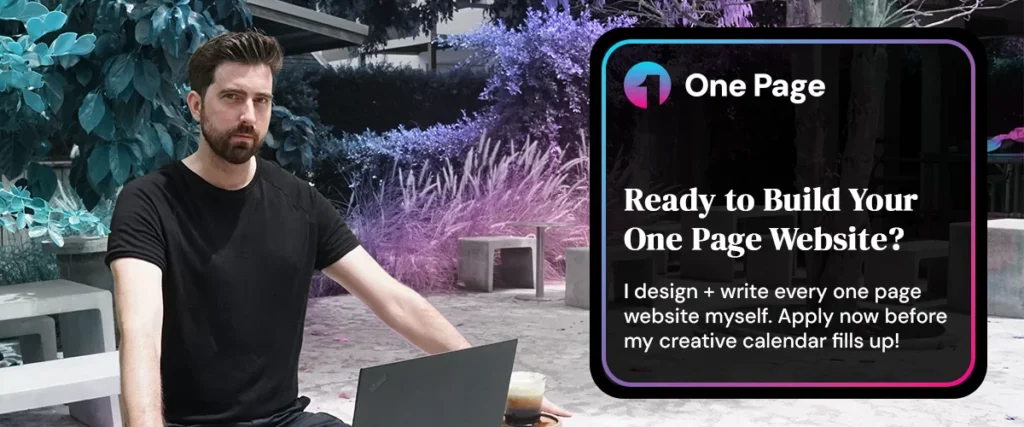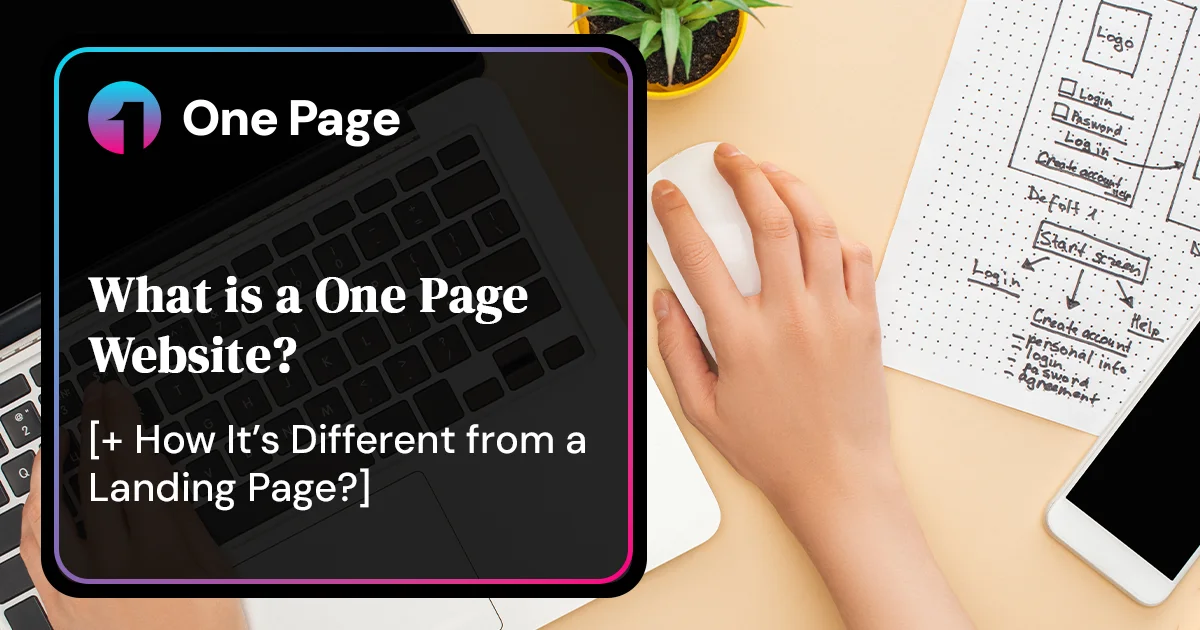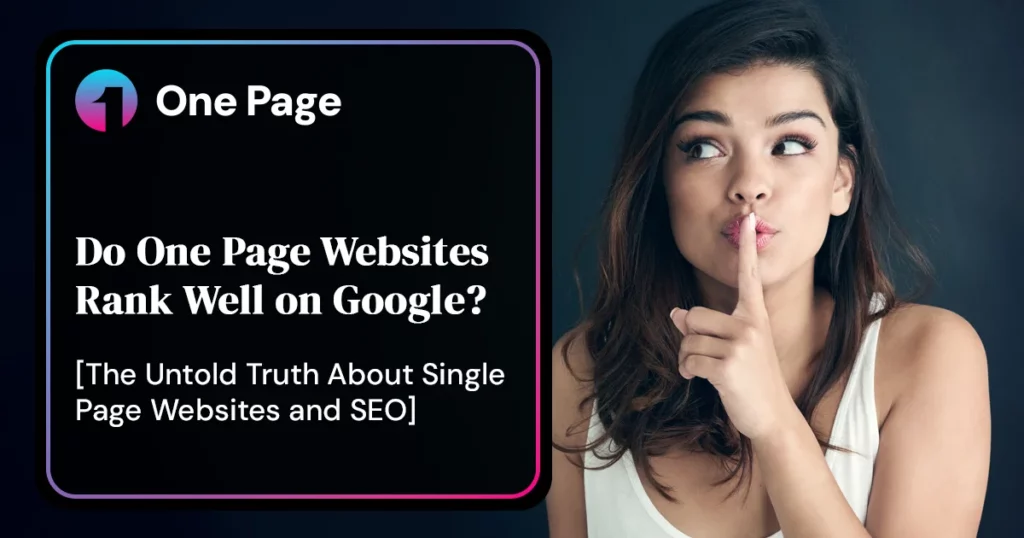What is a one page website? It’s a type of website built for simplicity where all your content, from services to contact info, lives on a single scrolling page. No extra clicks, no endless menus. Just a focused, conversion-friendly site that delivers information fast.
But is it the right choice for your business? Let’s break it down.
What is a One Page Website? And, How Does It Work?
Instead of having separate pages for “About,” “Services,” and “Contact,” a one-page website organizes everything into sections on the same page.
With a one page website, your visitors can scroll naturally or use a navigation menu with anchor links that jump to specific sections. This setup keeps everything accessible and helps visitors find information faster.
Who Should Use a One Page Website?
One-page websites work best for:
- Small businesses and freelancers needing a simple, low-maintenance online presence.
- Startups launching a new product or service and wanting a focused, conversion-driven site.
- Event promotions like conferences, workshops, or fundraisers.
- Portfolio websites for designers, photographers, and creatives who want a concise, visual showcase of their work.
One Page Website vs. Landing Page: What’s the Difference?
While one-page websites and landing pages may look similar, they serve different purposes. Here’s how they compare:
| Feature | One Page Website | Landing Page |
|---|---|---|
| Purpose | Functions as a full website, often serving as a brand’s primary online presence | Built for a single campaign, product, or offer with a clear conversion goal |
| Navigation | Includes a menu with anchor links to different sections | Typically avoids navigation to keep visitors focused on the CTA |
| SEO Benefits | Can rank for multiple keywords if structured properly but overall not very good for SEO | Usually optimized for a single keyword or set to no-index when used strictly for paid campaigns to avoid conflicting with SEO efforts. |
| Content Depth | Covers multiple sections: company info, services, testimonials, FAQs, contact details | Highly focused on one message and a direct conversion goal |
| User Journey | Can be designed to drive a single action or provide additional pathways, such as contacting or accessing a blog for more info. | Funnels visitors toward a single action, such as signing up or making a purchase |
| Call to Action (CTA) | Typically includes multiple CTAs—a primary conversion goal plus additional options like contact info, social links, or exploring blog content | Designed around one dominant CTA with minimal distractions |
| Conversion Focus | Balances information and conversion, giving visitors multiple ways to engage | Hyper-focused on one specific conversion objective, minimizing any competing elements |
Clarifying the CTA Difference
A landing page is designed for one primary action—it’s built to convert visitors into leads or customers without distractions. Everything on the page is aligned with this goal, whether it’s filling out a form, scheduling a call, or making a purchase.
A one-page website, on the other hand, can be structured in different ways depending on its purpose. Some are designed like landing pages, with a singular, hyper-focused CTA. Others provide multiple engagement opportunities while still driving conversions. It might include:
- A primary CTA (e.g., “Book a Consultation” or “Buy Now”)
- Supporting CTAs like “Learn More,” “Contact Us,” or “See Pricing”
- A footer with contact info and social links for alternative engagement options
The difference comes down to intent. A landing page eliminates distractions to maximize conversions, while a one-page website balances conversion with information.
Can a One Page Website Rank Well on Google?
Let’s face it, ranking on Google in 2025 is more competitive than ever. With Google’s E-E-A-T (Experience, Expertise, Authoritativeness, and Trustworthiness) framework shaping search results, a multi-page website is typically the better choice for long-term SEO success—especially for businesses relying on organic traffic.
That said, does this mean a one-page website can’t rank? Not necessarily. While it may not be the ideal structure for large-scale SEO, there are still strategies to make it work.
How a One Page Website Can Compete in Search Rankings
Unlike multi-page sites that spread SEO authority across multiple pages, a one-page website concentrates all of its ranking power into a single destination. If optimized properly, this can be an advantage for niche industries, local businesses, and hyper-targeted searches.
Here’s what makes a one-page website viable for SEO:
- Laser-Focused Keyword Targeting – With limited real estate, keyword strategy needs to be intentional. A one-page site should target a tightly clustered set of related keywords rather than trying to rank for everything. Instead of “Web Design Services,” for example, it’s better to aim for something specific like “Affordable Web Design for Therapists in Toronto.”
- Speed and Mobile-Friendliness Matter – Google prioritizes fast-loading, mobile-friendly sites. A one-page website, if built lean and optimized, can outperform bulky multi-page sites in page speed—an important ranking factor. With fewer requests and minimal complexity, a well-built one-page website can load almost instantly.
- Conversion-Driven User Experience – Google analyzes how users interact with a page. A high bounce rate signals weak content—but a one-page website designed for engagement, with clear sections and CTAs, can keep visitors scrolling, clicking, and converting. This positive user behavior sends strong ranking signals.
While multi-page websites have advantages for broader SEO strategies, a well-built one-page website can still rank competitively—especially for niche industries, local businesses, and service providers.
The Honest SEO Challenges of a One Page Website
Even with a well-optimized structure, one-page websites face major SEO limitations that can hold them back in competitive markets.
1. Limited Keyword Targeting 🎯
One-page websites struggle to rank for multiple keywords.
- A multi-page site lets you create dedicated service pages that target unique keywords.
- A one-page site? It forces you to cram everything into a single URL—which limits search visibility.
- If you want to rank for “Therapist Web Design,” “Affordable Web Design,” and “SEO-Friendly Web Design,” you’re stuck trying to balance all those terms on the same page—which dilutes keyword effectiveness.
Imagine you’re a personal trainer offering multiple services:
- “Weight Loss Training”
- “Strength Training for Athletes”
- “Post-Injury Rehabilitation”
With a multi-page website, you can create dedicated service pages that each target a different audience and keyword.
But with a one-page website, you’re forced to fit all these terms into a single page—which confuses search engines and weakens keyword relevance.
Instead of ranking well for each service separately, Google sees a mixed bag of keywords—making it harder for any one of them to rank competitively.
This is why multi-page websites dominate competitive SEO—they let you create focused, keyword-rich pages that align with what users are actually searching for.
2. Weak E-E-A-T Authority (Bad for Google) 📉
Google prioritizes websites that demonstrate deep expertise.
- Multi-page sites build credibility with in-depth service pages, client case studies, and educational content.
- A one-page website lacks the depth to establish strong Experience, Expertise, Authority, and Trust (E-E-A-T).
If Google sees thin content, it’s less likely to rank your site above competitors with more authoritative content.
3. SEO Growth Ceiling 📊
A one-page website is hard to scale.
- Once your content is optimized, where do you go from there?
- Adding more text makes the page overwhelming for users.
- Expanding your SEO strategy requires a major website redesign—or a switch to a multi-page structure.
With a multi-page website, you can add new service pages, expand content, and improve rankings over time.
Bottom Line: Can a One Page Website Compete?
✅ For small, niche businesses with focused search intent, a one-page site can work—if optimized properly.
❌ For competitive industries, local businesses, or long-term SEO growth, a multi-page website is the smarter investment.
So How Can You Get a One Page Website to Rank?
I won’t pretend that a one-page website is an SEO powerhouse. But if done right, it can still rank—just not in the same way a multi-page site does.
So, what if you do want to grow your SEO over time?
If you’re relying on a one-page website, you’ll need a strategy beyond just a well-optimized layout.
One of the best ways to boost SEO for a one-page website is to integrate a blog via a CMS like WordPress. This allows for ongoing content creation, internal linking, and authority building—critical for long-term search visibility.
But this raises the question:
👉 If you’re adding a blog, is it still a one-page website?
At that point, why not just invest in a full multi-page website? If SEO is your priority, wouldn’t a dedicated homepage, service pages, and blog posts make more sense than trying to force everything into one page?
The answer depends on your goals.
If you want a minimalist, conversion-driven website with a narrow SEO focus, a one-page site can work—but only if you’re strategic. If ranking broadly, establishing authority, and expanding visibility matter, a multi-page website is the better long-term investment.

Will You Choose a One Page Website?
Now that you understand what a one-page website is, it’s clear that this type of site is best for businesses that need a simple, focused online presence—one that prioritizes user experience and conversions. However, if your business depends on ranking for multiple keywords or publishing ongoing content like blogs, a multi-page site might be a better fit.
Want a website that works without the complexity? A one-page website gets your business online faster, keeps visitors engaged, and drives conversions—all without the hassle of a bloated site.
Take the next step and let’s build a website that helps you get results.


